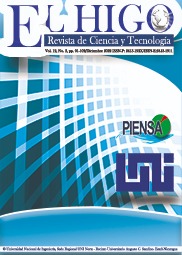Arbuscular mycorrhizal fungi: the symbiosis of multiple benefits
DOI:
https://doi.org/10.5377/elhigo.v12i2.15196Keywords:
Agricultural biotechnology, bioprotectors, biofertilizers, soil quality, environmentAbstract
Given the various natural and anthropogenic phenomena that are taking place globally, it is necessary to use biotechnological tools that maximize the response capabilities of organisms in their multiple environments. Arbuscular mycorrhizal fungi (AMF) are the optimal alternative to satisfy the current demand of the agricultural sector in harmony with the ecosystem;
This article aims to corroborate the multiple benefits reported by this symbiotic association through a review and analysis of the state of the art. The AMF-plant interaction creates tolerance to abiotic stress factors, promotes plant growth and an increase in productivity, there is also a special promotion in pest biocontrol, reports an increase in soil quality and absorption of heavy metals and could be a key tool in mitigating climate change. The AMF are an option that allows restoring the ecological role of soil microbiology with crops, in order to comply with sustainable development, proposed by the United Nations Organization (UN), which has a common and universal commitment: to eradicate poverty and promote food security.
Downloads
References
Abeer, H., Abd_Allah, E. F., Alqarawi, A. A., & Dilfuza, E. (2015). Induction of salt stress tolerance in cowpea [Vigna unguiculata (L.) Walp.] by arbuscular mycorrhizal fungi. Legume Research, 38(5), 579–588.
Abeer, H., Abd Allah, E. F., Alqarawi, A. A., Al-Huqail, A. A., & Shah, M. A. (2016). Induction of Osmoregulation and Modulation of Salt Stress in Acacia gerrardii Benth. by Arbuscular Mycorrhizal Fungi and Bacillus subtilis (BERA 71). BioMed Research International, 2016. Doi: 10.1155/2016/6294098
Aguilar, W., Arce, P., Galiano, F., & Torres, T. (2016). Aislamiento de esporas y evaluación de métodos de inoculación en la producción de micorrizas en cultivos trampa. Tecnología En Marcha, Especial B. Recuperado de https://www.scielo.sa.cr/pdf/tem/v29s3/0379-3982-tem-29-s3-5.pdf
Ait-El-Mokhtar, M., Baslam, M., Ben-Laouane, R., Anli, M., Boutasknit, A., Mitsui, T., Wahbi, S., & Meddich, A. (2020). Alleviation of Detrimental Effects of Salt Stress on Date Palm (Phoenix dactylifera L.) by the Application of Arbuscular Mycorrhizal Fungi and/or Compost. Frontiers in Sustainable Food Systems, 4, 131. Doi: 10.3389/FSUFS.2020.00131/BIBTEX
Barto, E. K., Weidenhamer, J. D., Cipollini, D., & Rillig, M. C. (2012). Fungal superhighways: do common mycorrhizal networks enhance below ground communication? Trends in Plant Science, 17(11), 633–637. Doi:10.1016/J.TPLANTS.2012.06.007
Barbosa, M. V., Pedroso, D. D. F., Curi, N., & Carneiro, M. A. C. (2019). Do different arbuscular mycorrhizal fungi affect the formation and stability of soil aggregates? Ciência e Agrotecnologia, 43. Doi: 10.1590/1413-7054201943003519
Baslam, M., Qaddoury, A., & Goicoechea, N. (2014). Role of native and exotic mycorrhizal symbiosis to develop morphological, physiological and biochemical responses coping with water drought of date palm, Phoenix dactylifera. Trees - Structure and Function, 28(1), 161–172. Doi: 10.1007/S00468-013-0939-0/FIGURES/4
Baum, C., El-Tohamy, W., & Gruda, N. (2015). Increasing the productivity and product quality of vegetable crops using arbuscular mycorrhizal fungi: A review. Scientia Horticulturae, 187, 131–141. Doi: 10.1016/J.SCIENTA.2015.03.002
Benítez-Díaz, P., & Miranda-Contreras, L. (2013). Contaminación de aguas superficiales por residuos de plaguicidas en venezuela y otros países de latinoamérica. Revista Internacional de Contaminación Ambiental, 29, 7–23. Recuperado a partir de https://www.revistascca.unam.mx/rica/index.php/rica/article/view/41043
Bhaduri, A. M., & Fulekar, M. H. (2012). Assessment of arbuscular mycorrhizal fungi on the phytoremediation potential of Ipomoea aquatica on cadmium uptake. Biotech , 2(3), 193–198. Doi: 10.1007/S13205-012-0046-8
Cao, J., Wang, C., Dou, Z., Liu, M., & Ji, D. (2018). Hyphospheric impacts of earthworms and arbuscular mycorrhizal fungus on soil bacterial community to promote oxytetracycline degradation. Journal of Hazardous Materials, 341, 346–354. Doi: 10.1016/J.JHAZMAT.2017.07.038
Carreón-Abud, Y., Jerónimo-Treviño, E., Beltrán-Nambo, M. D. L. Á., Martínez-Trujillo, M., Trejo Aguilar, D., & Gavito, M. E. (2013). Aislamiento y propagación de cultivos puros de hongos micorrízicos arbusculares provenientes de huertas de aguacate con diferente manejo agrícola por la técnica de minirizotrón. Revista mexicana de micología, 37, 29-39. Recuperado de: https://www.scielo.org.mx/scielo.php?script=sci_arttext&pid=S0187-31802013000100005
Cavagnaro, T. R., Bender, S. F., Asghari, H. R., & van der Heijden, M. G. A. (2015). The role of arbuscular mycorrhizas in reducing soil nutrient loss. Trends in Plant Science, 20(5), 283–290. Doi: 10.1016/J.TPLANTS.2015.03.004
Dhalaria, R., Kumar, D., Kumar, H., Nepovimova, E., Kuca, K., Islam, M. T., & Verma, R. (2020). Arbuscular Mycorrhizal Fungi as Potential Agents in Ameliorating Heavy Metal Stress in Plants. Agronomy 2020, Vol. 10, Page 815, 10(6), 815. Doi: 10.3390/AGRONOMY10060815
Duan, H. X., Luo, C. L., Li, J. Y., Wang, B. Z., Naseer, M., & Xiong, Y. C. (2021). Improvement of wheat productivity and soil quality by arbuscular mycorrhizal fungi is density- and moisture-dependent. Agronomy for Sustainable Development, 41(1), 1–12. Doi: 10.1007/S13593-020-00659-8/FIGURES/5
Durán, P., Acuña, J. J., Jorquera, M. A., Azcón, R., Borie, F., Cornejo, P., & Mora, M. L. (2013). Enhanced selenium content in wheat grain by co-inoculation of selenobacteria and arbuscular mycorrhizal fungi: A preliminary study as a potential Se biofortification strategy. Journal of Cereal Science, 57(3), 275–280. Doi: 10.1016/J.JCS.2012.11.012
Fan, X., Chang, W., Sui, X., Liu, Y., Song, G., Song, F., & Feng, F. (2020). Changes in rhizobacterial community mediating atrazine dissipation by arbuscular mycorrhiza. Chemosphere, 256, 127046. Doi: 10.1016/J.CHEMOSPHERE.2020.127046
Gardezi, A. K., Berber, S. R. M., & Garay, A. V. A. (2015). Los usos y beneficios de las micorrizas en la agricultura. Desarrollo y tecnología: Aportaciones a los problemas de la sociedad, Plaza y Valdez, 243-265.
Gunathilakae, N., Yapa, N., & Hettiarachchi, R. (2018). Effect of arbuscular mycorrhizal fungi on the cadmium phytoremediation potential of Eichhornia crassipes (Mart.) Solms. Groundwater for Sustainable Development, 7, 477–482. Doi: 10.1016/J.GSD.2018.03.008
Hernández Hernández, C. (2019). Simbiosis micorrízica arbuscular y hongos entomopatógenos endófitos en maíz como bioprotectores contra el gusano cogollero. (Master dissertation, Universidad Michoacana de San Nicolás Hidalgo).
Hernández, M., & Chailloux, M. (2014). las micorrizas arbusculares y las bacterias rizosféricas como alternativa a la nutrición mineral del tomate. Cultivos Tropicales, 25(2), 5–12. Recuperado de https://www.redalyc.org/articulo.oa?id=193217832001.
Leifheit, E. F., Veresoglou, S. D., Lehmann, A., Morris, E. K., & Rillig, M. C. (2014). Multiple factors influence the role of arbuscular mycorrhizal fungi in soil aggregation-a meta-analysis. Plant and Soil, 374(1–2), 523–537. Doi: 10.1007/S11104-013-1899-2/TABLES/1
López, M. (2016). Estudio comparativo de los tratamientos biológico y químico convencional en el cultivo de frijol (Phaseolus vulgaris L.) Variedad Jamapa. (Master dissertation, Instituto Politécnico Nacional México)
Meira, P. (2013). Problemas ambientales globales y educación ambiental, Una aproximación desde las representaciones sociales del cambio climático ll: Una aproximación desde las representaciones sociales del cambio climático. Rev. de Inv. Educ., 6(3), 29–64. Recuperado de: http://www.scielo.org.bo/pdf/rieiii/v6n3/n6a03.pdf
Minzer, R., Romero, I., y Orozco, R. C. (2017). Análisis estructural de la economía nicaragüense: el mercado laboral. Informe técnico. Disponible en: https://repositorio.cepal.org/bitstream/handle/11362/41942/1/S1700547_es.pdf
Mohamed, I., Eid, K. E., Abbas, M. H. H., Salem, A. A., Ahmed, N., Ali, M., Shah, G. M., & Fang, C. (2019). Use of plant growth promoting Rhizobacteria (PGPR) and mycorrhizae to improve the growth and nutrient utilization of common bean in a soil infected with white rot fungi. Ecotoxicology and Environmental Safety, 171, 539–548. Doi: 10.1016/J.ECOENV.2018.12.100.
Montoya Martínez, A. C. (2014). Hongos micorrízicos como biofertilizantes y agentes de control biológico contra Fusarium oxysporum en Agave tequilana. (Bachelor's thesis, Universidad Michoacana de San Nicolás de Hidalgo).
Moran Bolaños, N. (2021). Comportamiento agronómico del cultivo de maní (Arachis hypogaea L.) con aplicación de microorganismos benéficos (Micorrizas y Rizobacterias) (Bachelor's thesis, Universidad Estatal del Sur de Manabí).
Muñoz Carrillo, M. G. (2018). Análisis de expresión de genes de respuesta al estrés hídrico en plantas de Sorghum bicolor (L) Moench en presencia y ausencia de asociaciones con hongos micorrízicos (Doctoral dissertation, Universidad Autónoma de Aguascalientes).
Ojeda, L., Furrazola, E., & Hernández, C. (2014). Micorrizas arbusculares en leguminosas de la empresa pecuaria El Tablón, Cuba. Pastos y Forraje, 37(4), 392–398. Recuperado de http://scielo.sld.cu/pdf/pyf/v37n4/pyf02414.pdf
Oliveira, R. S., Carvalho, P., Marques, G., Ferreira, L., Nunes, M., Rocha, I., Ma, Y., Carvalho, M. F., Vosátka, M., & Freitas, H. (2017). Increased protein content of chickpea (Cicer arietinum L.) inoculated with arbuscular mycorrhizal fungi and nitrogen-fixing bacteria under water deficit conditions. Journal of the Science of Food and Agriculture, 97(13), 4379–4385. Doi: 10.1002/JSFA.8201
Pérez Moncada, U. A., Gómez, M. R., Serralde Ordoñez, D. P., Peñaranda Rolón, A. M., Wilches Ortiz, W. A., Ramírez, L., & Rengifo Estrada, G. A. (2019). Hongos formadores de micorrizas arbusculares (HFMA) como estrategia para reducir la absorción de cadmio en plantas de cacao (Theobroma cacao). Terra Latinoamericana, 37(2), 121–130. Doi: 10.28940/TERRA.V37I2.479
Porcel, R., Aroca, R., & Ruiz-Lozano, J. M. (2012). Salinity stress alleviation using arbuscular mycorrhizal fungi. A review. Agronomy for Sustainable Development, 32(1), 181–200. Doi: 10.1007/S13593-011-0029-X
Recchia, G. H., Konzen, E. R., Cassieri, F., Caldasand, D. G. G., & Tsai, S. M. (2018). Arbuscular Mycorrhizal Symbiosis Leads to Differential Regulation of Drought-Responsive Genes in Tissue-Specific Root Cells of Common Bean. Frontiers in Microbiology, 9, 1–24. Doi: 10.3389/fmicb.2018.01339
Reyes, H. A., Ferreira, P. F. A., Silva, L. C., da Costa, M. G., Nobre, C. P., & Gehring, C. (2019). Arbuscular mycorrhizal fungi along secondary forest succession at the eastern periphery of Amazonia: Seasonal variability and impacts of soil fertility. Applied Soil Ecology, 136, 1-10. Doi: 10.1016/j.apsoil.2018.12.013
Ruiz, P., Rojas, K., & Sieverding, E. (2013). La distribución geográfica de los hongos de micorriza arbuscular: una prioridad de investigación en la Amazonía peruana. 23, 47–63. Recuperado a partir de https://revistas.pucp.edu.pe/index.php/espacioydesarrollo/article/view/3479
Singh, P. K., Singh, M., & Tripathi, B. N. (2013). Glomalin: An arbuscular mycorrhizal fungal soil protein. Protoplasma, 250(3), 663–669. Doi: 10.1007/S00709-012-0453-Z/TABLES/2}
Torres, G. V., Pisco, A. S., & Lopez, L. A. A. (2021). Efecto Bioprotector de Micorrizas Arbusculares en la Reducción de Roya (Hemileia vastatrix) en la Región San Martín. Revista Agrotecnológica Amazónica, 1(1), 34-44. Doi: https://doi.org/10.51252/raa.v1i1.122
Weisany, W., Raei, Y., Salmasi, S. Z., Sohrabi, Y., & Ghassemi-Golezani, K. (2016). Arbuscular mycorrhizal fungi induced changes in rhizosphere, essential oil and mineral nutrients uptake in dill/common bean intercropping system. Annals of Applied Biology, 169(3), 384–397. Doi: 10.1111/AAB.12309
Xu, J., Liu, S., Song, S., Guo, H., Tang, J., Yong, J. W. H., Ma, Y., & Chen, X. (2018). Arbuscular mycorrhizal fungi influence decomposition and the associated soil microbial community under different soil phosphorus availability. Soil Biology and Biochemistry, 120, 181–190. Doi: doi.org/10.1016/J.SOILBIO.2018.02.010
Yagoob, A., Mohammad Reza, Zardashti Jalilian, J., & Eini, O. (2012). Efectos de los hongos micorrízicos arbusculares sobre el rendimiento de semillas y proteínas bajo estrés por déficit de agua en frijol mungo. Agronomy, Soil y Envirnmental Quality, 105(1), 79–84. Doi: 10.2134/agronj2012.0069
Yang, S. Y., Grønlund, M., Jakobsen, I., Grotemeyer, M. S., Rentsch, D., Miyao, A., Hirochika, H., Kumar, C. S., Sundaresan, V., Salamin, N., Catausan, S., Mattes, N., Heuer, S., & Paszkowski, U. (2012). Nonredundant Regulation of Rice Arbuscular Mycorrhizal Symbiosis by Two Members of the PHOSPHATE TRANSPORTER1 Gene Family. The Plant Cell, 24(10), 4236–4251. Doi: 10.1105/TPC.112.104901
Downloads
Published
How to Cite
Issue
Section
License
Copyright (c) 2022 Universidad Nacional de Ingeniería

This work is licensed under a Creative Commons Attribution-NonCommercial-NoDerivatives 4.0 International License.
Los artículos publicados en la revista El Higo, Nicaragua, se comparten bajo términos de la licencia Creative Commons: Reconocimiento, No Comercial, Compartir Igual. que permite a terceros utilizar lo publicado siempre que mencionen la autoría del trabajo y a la primera publicación en esta revista. ![]()
Los autores/as pueden realizar otros acuerdos contractuales independientes y adicionales para la distribución no exclusiva de la versión del artículo publicado en esta revista (p. ej., incluirlo en un repositorio institucional o publicarlo en un libro) siempre que indiquen claramente que el trabajo se publicó por primera vez en esta revista.






